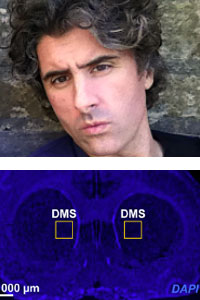Featured Paper of the Month – April 2017
Caprioli, Daniele; Venniro, Marco; Zhang, Michelle; Bossert, Jennifer M; Warren, Brandon L; Hope, Bruce T; Shaham, Yavin
Role of Dorsomedial Striatum Neuronal Ensembles in Incubation of Methamphetamine Craving after Voluntary Abstinence. Journal Article
In: J Neurosci, vol. 37, no. 4, pp. 1014–1027, 2017, ISSN: 1529-2401 (Electronic); 0270-6474 (Linking).
@article{Caprioli:2017aa,
title = {Role of Dorsomedial Striatum Neuronal Ensembles in Incubation of Methamphetamine Craving after Voluntary Abstinence.},
author = {Daniele Caprioli and Marco Venniro and Michelle Zhang and Jennifer M Bossert and Brandon L Warren and Bruce T Hope and Yavin Shaham},
url = {https://www.ncbi.nlm.nih.gov/pubmed/28123032},
doi = {10.1523/JNEUROSCI.3091-16.2016},
issn = {1529-2401 (Electronic); 0270-6474 (Linking)},
year = {2017},
date = {2017-01-25},
urldate = {2017-01-25},
journal = {J Neurosci},
volume = {37},
number = {4},
pages = {1014--1027},
address = {Behavioral Neuroscience Research Branch, Intramural Research Program, National Institute on Drug Abuse, National Institutes of Health, Baltimore, Maryland 21224 daniele.caprioli@uniroma1.it yavin.shaham@nih.gov.},
abstract = {We recently developed a rat model of incubation of methamphetamine craving after choice-based voluntary abstinence. Here, we studied the role of dorsolateral striatum (DLS) and dorsomedial striatum (DMS) in this incubation. We trained rats to self-administer palatable food pellets (6 d, 6 h/d) and methamphetamine (12 d, 6 h/d). We then assessed relapse to methamphetamine seeking under extinction conditions after 1 and 21 abstinence days. Between tests, the rats underwent voluntary abstinence (using a discrete choice procedure between methamphetamine and food; 20 trials/d) for 19 d. We used in situ hybridization to measure the colabeling of the activity marker Fos with Drd1 and Drd2 in DMS and DLS after the tests. Based on the in situ hybridization colabeling results, we tested the causal role of DMS D1 and D2 family receptors, and DMS neuronal ensembles in "incubated" methamphetamine seeking, using selective dopamine receptor antagonists (SCH39166 or raclopride) and the Daun02 chemogenetic inactivation procedure, respectively. Methamphetamine seeking was higher after 21 d of voluntary abstinence than after 1 d (incubation of methamphetamine craving). The incubated response was associated with increased Fos expression in DMS but not in DLS; Fos was colabeled with both Drd1 and Drd2 DMS injections of SCH39166 or raclopride selectively decreased methamphetamine seeking after 21 abstinence days. In Fos-lacZ transgenic rats, selective inactivation of relapse test-activated Fos neurons in DMS on abstinence day 18 decreased incubated methamphetamine seeking on day 21. Results demonstrate a role of DMS dopamine D1 and D2 receptors in the incubation of methamphetamine craving after voluntary abstinence and that DMS neuronal ensembles mediate this incubation. SIGNIFICANCE STATEMENT: In human addicts, abstinence is often self-imposed and relapse can be triggered by exposure to drug-associated cues that induce drug craving. We recently developed a rat model of incubation of methamphetamine craving after choice-based voluntary abstinence. Here, we used classical pharmacology, in situ hybridization, immunohistochemistry, and the Daun02 inactivation procedure to demonstrate a critical role of dorsomedial striatum neuronal ensembles in this new form of incubation of drug craving.},
keywords = {},
pubstate = {published},
tppubtype = {article}
}
We recently developed a rat model of incubation of methamphetamine craving after choice-based voluntary abstinence. Here, we studied the role of dorsolateral striatum (DLS) and dorsomedial striatum (DMS) in this incubation. We trained rats to self-administer palatable food pellets (6 d, 6 h/d) and methamphetamine (12 d, 6 h/d). We then assessed relapse to methamphetamine seeking under extinction conditions after 1 and 21 abstinence days. Between tests, the rats underwent voluntary abstinence (using a discrete choice procedure between methamphetamine and food; 20 trials/d) for 19 d. We used in situ hybridization to measure the colabeling of the activity marker Fos with Drd1 and Drd2 in DMS and DLS after the tests. Based on the in situ hybridization colabeling results, we tested the causal role of DMS D1 and D2 family receptors, and DMS neuronal ensembles in "incubated" methamphetamine seeking, using selective dopamine receptor antagonists (SCH39166 or raclopride) and the Daun02 chemogenetic inactivation procedure, respectively. Methamphetamine seeking was higher after 21 d of voluntary abstinence than after 1 d (incubation of methamphetamine craving). The incubated response was associated with increased Fos expression in DMS but not in DLS; Fos was colabeled with both Drd1 and Drd2 DMS injections of SCH39166 or raclopride selectively decreased methamphetamine seeking after 21 abstinence days. In Fos-lacZ transgenic rats, selective inactivation of relapse test-activated Fos neurons in DMS on abstinence day 18 decreased incubated methamphetamine seeking on day 21. Results demonstrate a role of DMS dopamine D1 and D2 receptors in the incubation of methamphetamine craving after voluntary abstinence and that DMS neuronal ensembles mediate this incubation. SIGNIFICANCE STATEMENT: In human addicts, abstinence is often self-imposed and relapse can be triggered by exposure to drug-associated cues that induce drug craving. We recently developed a rat model of incubation of methamphetamine craving after choice-based voluntary abstinence. Here, we used classical pharmacology, in situ hybridization, immunohistochemistry, and the Daun02 inactivation procedure to demonstrate a critical role of dorsomedial striatum neuronal ensembles in this new form of incubation of drug craving.

